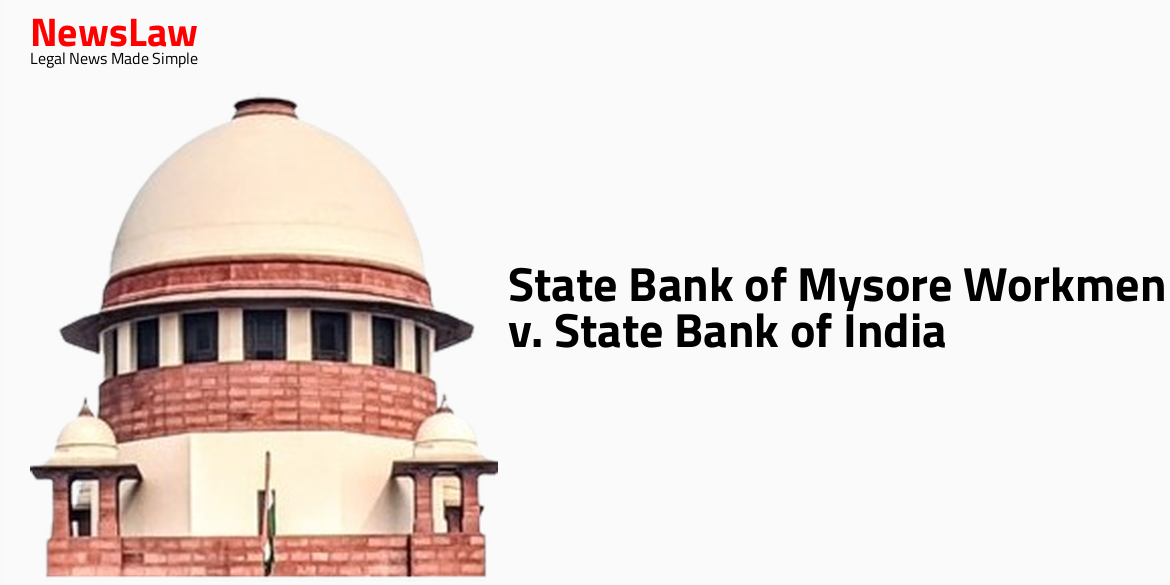In a recent case before the Delhi High Court, an industrial dispute arose between the workmen of State Bank of Mysore and State Bank of India. The petitioners sought reinstatement and regularization after receiving retrenchment notices due to a merger. The court’s judgment delves into the nuances of writ jurisdiction and the significance of exhausting alternative remedies before approaching higher courts. Let’s explore how this case sets a precedent for protecting legal rights in industrial disputes.
Facts
- The petitioners/workmen joined State Bank of Mysore on temporary basis as Sweeper/Sweeper-cum-Peon between 2004 to 2010.
- On 31 March, 2017, they received retrenchment notice due to the merger of six banks with State Bank of India.
- Petitioners sought reinstatement, regularization, and setting aside of retrenchment.
Arguments
- The petitioners worked with the respondent for over 240 days in a calendar year for the last 10 years.
- The petitioners claim they were assured of regularization but were terminated before the merger took place.
- The termination of the petitioners is challenged as discriminatory and violative of their legal and fundamental rights.
- The petitioners seek reinstatement and regularization based on their tenure with the respondent for 10 years.
- The counsel for the respondents argue that the termination was as per statutory mandate of Section 25-F of the Act.
- There is a preliminary objection raised regarding the maintainability of the instant petition due to the availability of an alternative remedy in the Industrial Tribunal/Labour Court under the Act.
- The writ jurisdiction of the High Court should be exercised reasonably and in accordance with the law.
- The respondents did not prepare a seniority list and chose a ‘pick and choose’ method for regularization post-merger.
- The merger scheme is alleged to be discriminatory and a violation of Article 14 of the Constitution of India.
- The petitioners claim the nature of their work was permanent and they should have been regularized based on seniority.
- The principle of exhaustion of alternatives remedy was discussed extensively.
- It emphasized the importance of approaching the forum closest in the judicial hierarchy to avoid forum shopping.
- Forum shopping can potentially waste judicial resources and lead to inefficiencies.
- Litigants should not strategically select forums for their advantage.
Analysis
- Courts should refrain from entertaining petitions when there is an alternative remedy available to the aggrieved party
- Exceptional circumstances may warrant the Court to exercise its powers even when an alternative remedy exists
- The exercise of writ jurisdiction is discretionary and subject to the presence of ‘exceptional circumstances’
- The High Court should not entertain petitions involving disputed facts
- The extraordinary nature of Article 226 of the Constitution imposes limitations on the Court’s discretion
- Writ petitions related to industrial disputes with statutory remedies should not be entertained without ‘exceptional circumstances’
- Alternative remedies should be exhausted before seeking recourse to writ jurisdiction
- Statutory forums for grievances should be preferred over writ petitions unless there is a violation of fundamental principles or natural justice
- The powers of a writ Court are subject to discretion and should not be invoked if alternative remedies exist
- Statutory design and policy require industrial disputes to be adjudicated by the Industrial Tribunal/Labour Courts initially.
- The decisions of the Tribunal/Labour Courts are subject to the High Court’s writ jurisdiction.
- Writ Courts can grant reliefs if an exceptional case is made or sufficient grounds exist.
- High Court should not interfere if an alternative remedy is available unless exceptional circumstances exist.
- High Court discretion to grant relief under Article 226 even if alternative remedy exists.
- Hierarchical structure reflects the legislative intent of the Industrial Disputes Act, 1947.
- The Act provides a detailed mechanism for resolving industrial disputes and remedies.
- No bar on writ Court’s powers under Article 226/227 despite the existence of alternative remedy.
- Petitioners failed to demonstrate exceptional circumstances for the court to exercise its jurisdiction under Article 226.
- The present petition is not maintainable under Article 226 as alternative remedy under the Act was not exhausted.
- No extraordinary writ jurisdiction was established by the petitioners in the matter.
- No observations on the merits of the case were made by the Court.
- The petitioners are free to assert their rights and approach the appropriate forum under the law.
- Time taken for disposal of the petition will not affect the limitation period to raise industrial dispute.
- Both parties have the option to approach the appropriate forum under the Act as the efficacious alternative remedy.
Decision
- Instant petition dismissed
- Pending applications also dismissed
Case Title: MAYA AND ORS Vs. UNION OF INDIA AND ORS (2024:DHC:4033)
Case Number: W.P.(C)-4455/2017



